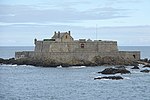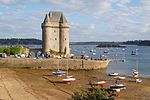Saint-Malo Cathedral

Saint-Malo Cathedral (Cathédrale Saint-Vincent-de-Saragosse de Saint-Malo) is a Catholic Cathedral located in Saint-Malo, Brittany, France. The church was founded in dedication to Saint Vincent of Saragossa and is a national monument of France. It was built in a mix of Romanesque and Gothic styles during the episcopacy of Jean de Châtillon (1146-1163) on the site of an ancient church founded in the 7th century. The cathedral suffered damage during World War II when the steeple toppled onto the Sacred Heart Chapel. An organ which had been built in 1893 by Louis Debierre was destroyed. On 21 May 1972, after 28 years of work, a ceremony was held to celebrate the completion of the restoration. It is a stop on the Tro Breizh, a Catholic pilgrimage that links the towns of the seven founding saints of Brittany.
Excerpt from the Wikipedia article Saint-Malo Cathedral (License: CC BY-SA 3.0, Authors, Images).Saint-Malo Cathedral
Rue Guillaume Le Gouverneur, Saint-Malo
Geographical coordinates (GPS) Address External links Nearby Places Show on map
Geographical coordinates (GPS)
| Latitude | Longitude |
|---|---|
| N 48.649444444444 ° | E -2.0255555555556 ° |
Address
Cathédrale Saint-Vincent
Rue Guillaume Le Gouverneur
35400 Saint-Malo, Intra-Muros
Brittany, France
Open on Google Maps











